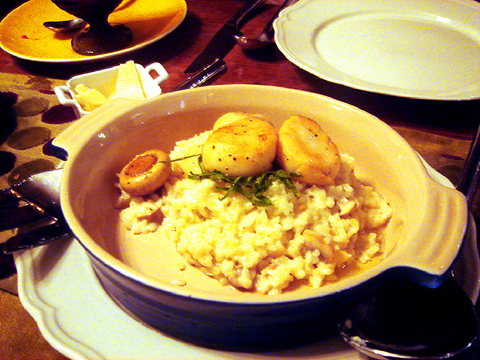The Taipei Times has twice reviewed VVG (Very Very Good) Bistro, of which VVG Table is a down-the-street offshoot. It was good then, and it remains good now. The original's cozy chaos contracts strongly with the design-conscious good-looks of the new joint.
The staff members, many of whom have studied in Europe, eschews a practice common to European-style restaurants in Taipei, which might generously be called "fusion." This is to say, instead of castrating their food to make it "conform to local taste," they spend considerable time and energy to do each dish properly.
In fact, be prepared to wait a bit for your food, because chances are that most of your order is going to be made from scratch. Past the semi-open porch and the rusticlassy wooden interior full of heavy wooden tables and an entire wall of wine, there is a beautiful open kitchen where you can see the chefs' heads bobbing over piles of fresh ingredients.

PHOTO: CHRIS PECHSTEDT, TAIPEI TIMES
The same thoughtfulness that goes into preparation and decoration goes into the menu. As I indiscreetly cast longing glances at my pumpkin soup (NT$180) and rocket salad with prosciutto, capsicum, and parmesan (NT$340), chef Vicky Huang (
The long prep-time for the main dishes makes it the sort of place where couples or larger groups with time to kill and money to burn can easily spend a long and comfortable summer evening.
Another big draw is the elaborate weekend brunch (NT$560, 11am to 4pm). This includes, but is not limited to, homemade bread, roast smoked salmon, chicken and zucchini skewers, and a dish described as "egg cups of crab and shrimp with quail egg and caviar." Cool drinks are served at strategic points through the meal, which ends with desert and cafe au lait or peppermint tea.
VVG Table is in a quiet maze of alleyways off the Zhongxiao-Dunhua intersection. It's not easy to find, but since it's made somewhat of a name for itself, most shopkeepers in the area should be able to provide directions.

As I finally slid into the warm embrace of the hot, clifftop pool, it was a serene moment of reflection. The sound of the river reflected off the cave walls, the white of our camping lights reflected off the dark, shimmering surface of the water, and I reflected on how fortunate I was to be here. After all, the beautiful walk through narrow canyons that had brought us here had been inaccessible for five years — and will be again soon. The day had started at the Huisun Forest Area (惠蓀林場), at the end of Nantou County Route 80, north and east

Specialty sandwiches loaded with the contents of an entire charcuterie board, overflowing with sauces, creams and all manner of creative add-ons, is perhaps one of the biggest global food trends of this year. From London to New York, lines form down the block for mortadella, burrata, pistachio and more stuffed between slices of fresh sourdough, rye or focaccia. To try the trend in Taipei, Munchies Mafia is for sure the spot — could this be the best sandwich in town? Carlos from Spain and Sergio from Mexico opened this spot just seven months ago. The two met working in the

Exceptions to the rule are sometimes revealing. For a brief few years, there was an emerging ideological split between the Democratic Progressive Party (DPP) and Chinese Nationalist Party (KMT) that appeared to be pushing the DPP in a direction that would be considered more liberal, and the KMT more conservative. In the previous column, “The KMT-DPP’s bureaucrat-led developmental state” (Dec. 11, page 12), we examined how Taiwan’s democratic system developed, and how both the two main parties largely accepted a similar consensus on how Taiwan should be run domestically and did not split along the left-right lines more familiar in

This month the government ordered a one-year block of Xiaohongshu (小紅書) or Rednote, a Chinese social media platform with more than 3 million users in Taiwan. The government pointed to widespread fraud activity on the platform, along with cybersecurity failures. Officials said that they had reached out to the company and asked it to change. However, they received no response. The pro-China parties, the Chinese Nationalist Party (KMT) and Taiwan People’s Party (TPP), immediately swung into action, denouncing the ban as an attack on free speech. This “free speech” claim was then echoed by the People’s Republic of China (PRC),